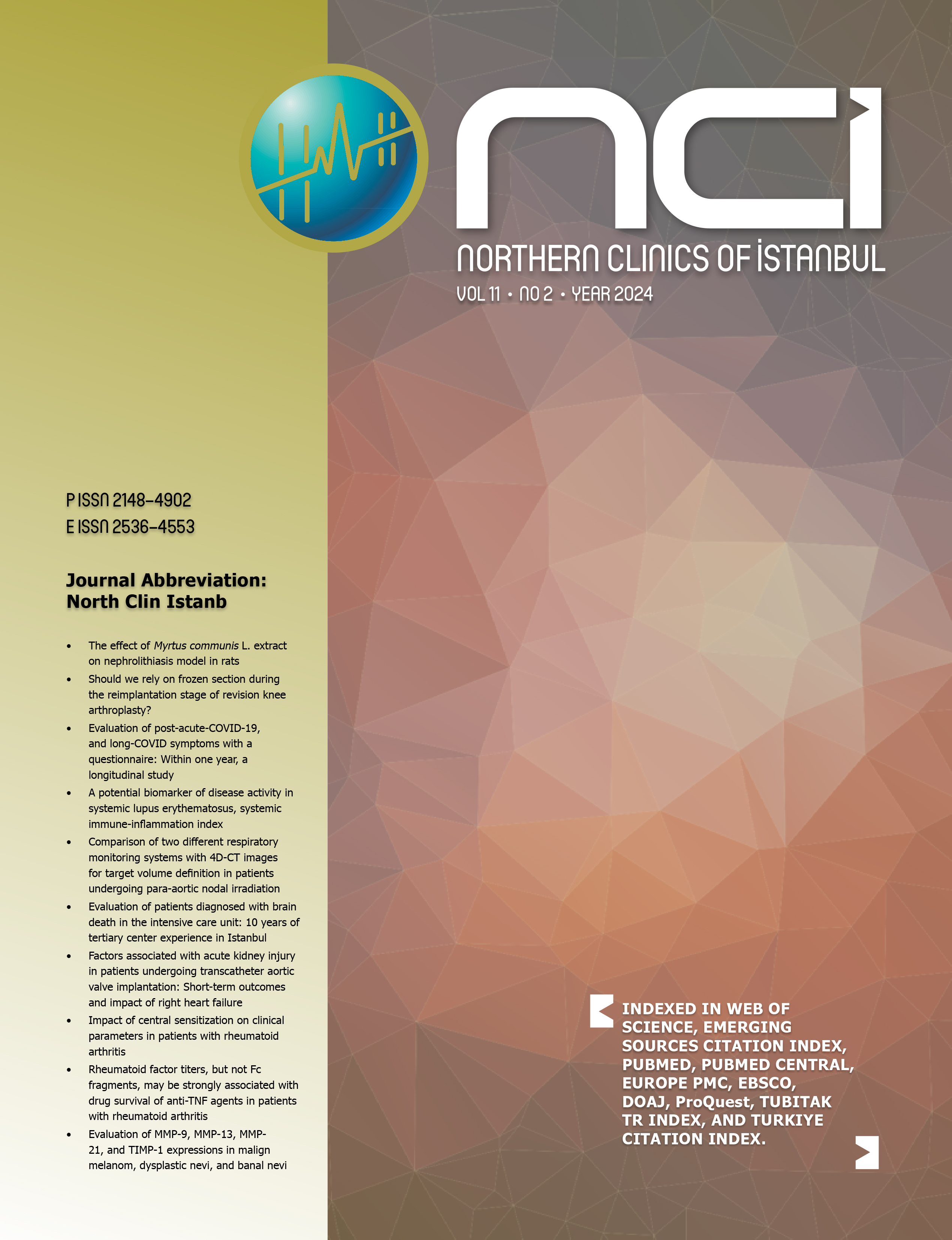Antihistamines and omalizumab combination treatment in patients with chronic spontaneous urticaria: Real-world experience from a tertiary care hospital
Dilek Mentesoglu, Gokce Isil Kurmus, Selda Pelin KartalDepartment of Dermatology and Venereology, Ankara Etlik City Hospital, Ankara, TurkiyeObjective: Chronic spontaneous urticaria is characterized by recurrent hives and/or angioedema that persists for more than six weeks, with unknown triggers. This study aimed to gather and analyze real-world data from adult patients diagnosed with chronic spontaneous urticaria who were receiving omalizumab treatment.
Methods: This retrospective observational study included adults who received omalizumab between September 2022 and February 2024.
Results: A total of 64 patients were included in the study, with a mean age of 44.3 years. Among them, 40 (62.5%) were female, and 24 (37.5%) were male. The mean duration of urticaria diagnosis was 46.6 months, with a mean omalizumab use of 23.6 months. Prior to omalizumab treatment, second-generation antihistamines (sgAHs) were the most commonly used treatment at the highest dose (60.9%) and oral steroid combination therapy (31.3%). All patients received omalizumab 300 mg once every four weeks from the start of treatment and continued using antihistamines. No significant correlation was observed between the antihistamine dosage and treatment response (p=0.06). An observed interval extension and/or dose increase was noted in 23.4% of the patients. The mean Urticaria Control Test (UCT) score, weekly Urticaria Activity Score (UAS7), and Dermatology Life Quality Index (DLQI) scores significantly improved from the first visit before omalizumab treatment to the last visit after treatment (all p<0.001). Of the patients, 98.4% responded moderately to treatment, 26.6% responded thoroughly, and 46.9% responded well. Only three patients (3.1%) experienced myalgia as a side effect of omalizumab therapy, with no severe adverse events reported.
Conclusion: Combination therapy with antihistamine and omalizumab is a reliable and beneficial therapy for managing chronic spontaneous urticaria.
Keywords: Antihistamine; chronic spontaneous urticaria; omalizumab; treatment.
Kronik spontan ürtikerli hastalarda antihistaminikler ve omalizumab kombinasyon tedavisi: Üçüncü basamak bir hastaneden gerçek dünya deneyimi
Dilek Mentesoglu, Gokce Isil Kurmus, Selda Pelin KartalAnkara Etlik Şehir Hastanesi, Dermatoloji ve Venereoloji Kliniği, AnkaraGiriş: Kronik spontan ürtiker, bilinmeyen tetikleyicilerle altı haftadan uzun süre devam eden tekrarlayan kurdeşen ve/veya anjiyoödem ile karakterizedir. Bu çalışma, omalizumab tedavisi alan kronik spontan ürtiker tanılı yetişkin hastalardan gerçek dünya verilerini toplamayı ve analiz etmeyi amaçlamıştır.
Yöntem: Bu retrospektif gözlemsel çalışmaya Eylül 2022 ile Şubat 2024 tarihleri arasında omalizumab alan yetişkinler dahil edilmiştir.
Bulgular: Ortalama yaşı 44.3 olan toplam 64 hasta çalışmaya dahil edildi. Hastaların 40'ı (%62,5) kadın, 24'ü (%37,5) erkekti. Ortalama ürtiker tanı süresi 46,6 ay, ortalama omalizumab kullanım süresi ise 23,6 aydı. Omalizumab tedavisinden önce, en yüksek dozda ikinci nesil antihistaminikler (sgAH'lar) (%60,9) ve oral steroid kombinasyon tedavisi (%31,3) en sık kullanılan tedaviydi. Tüm hastalar tedavinin başlangıcından itibaren dört haftada bir 300 mg omalizumab almış ve antihistaminik kullanmaya devam etmiştir. Antihistaminik dozu ile tedavi yanıtı arasında anlamlı bir korelasyon gözlenmemiştir (p = 0.06). Hastaların %23,4'ünde gözlenen bir aralık uzaması ve/veya doz artışı kaydedilmiştir. Ortalama Ürtiker Kontrol Testi (UCT) skoru, haftalık Ürtiker Aktivite Skoru (UAS7), ve Dermatoloji Yaşam Kalitesi İndeksi (DLQI) skorları omalizumab tedavisinden önceki ilk vizitten tedaviden sonraki son vizite kadar anlamlı şekilde iyileşmiştir (tümü p<0.001). Hastaların %98,4'ü tedaviye orta düzeyde yanıt verirken, %26,6'sı tam yanıt vermiş ve %46,9'u iyi yanıt vermiştir. Sadece üç hastada (%3,1) omalizumab tedavisinin yan etkisi olarak miyalji görülmüş ve ciddi advers olay bildirilmemiştir.
Sonuç: Antihistaminik ve omalizumab ile kombinasyon tedavisi kronik spontan ürtiker tedavisinde güvenilir ve faydalı bir tedavidir. (NCI-2024-3-21)
Anahtar Kelimeler: Antihistaminik; kronik spontan ürtiker; omalizumab; tedavi.
Manuscript Language: English





















